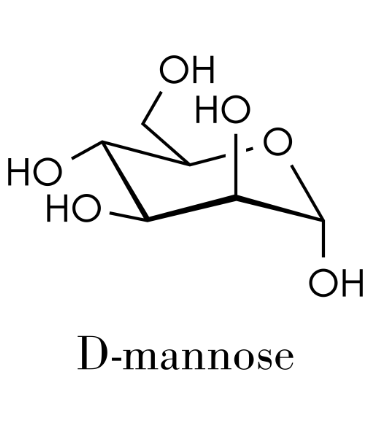
D-Mannose

Description
D-mannose is a monosaccharide, i.e. a simple sugar, found in certain fruits such as cranberries, blueberries, apples, peaches and oranges. It is also present in the body, but in smaller quantities.
Although it has a chemical structure similar to that of glucose, D-mannose has the particularity of not being stored by the body and of being eliminated in its initial form in the urine (1).
The mechanism of action of D-mannose consists of binding to the adhesion proteins, also known as pili and fimbriae, of bacteria such as Escherichia coli. It is known that when these bacteria are present in excessive quantities, they cause urinary tract infections by attaching to the bladder wall (2).
By binding to pili, D-mannose neutralises these bacteria, preventing them from adhering to urothelial cells, thus leading to their urinary elimination. This is why D-mannose is a promising non-antibiotic prevention and treatment strategy, especially for urinary tract infections, including cystitis (3).
The benefits
D-mannose is a simple carbohydrate known for its beneficial properties in cases of urinary tract infection. Specifically, it saturates bacterial adhesion proteins, called adhesins, and thus prevents the bacteria from binding to urothelial receptors. As the bacteria are no longer able to attach, they are eliminated through the urine.
Publications
To date, D-mannose has been the subject of more than 36 000 publications scientifiques.
1. Sharma V, Ichikawa M, Freeze HH. Mannose metabolism: more than meets the eye. Biochem Biophys Res Commun. 2014;453(2):220-228. doi:10.1016/j.bbrc.2014.06.02
2. De Nunzio C, Bartoletti R, Tubaro A, Simonato A, Ficarra V. Role of D-Mannose in the Prevention of Recurrent Uncomplicated Cystitis: State of the Art and Future Perspectives. Antibiotics (Basel). 2021;10(4):373. Published 2021 Apr 1. doi:10.3390/antibiotics1004037
3. Ala-Jaakkola R, Laitila A, Ouwehand AC, Lehtoranta L. Role of D-mannose in urinary tract infections - a narrative review. Nutr J. 2022;21(1):18. Published 2022 Mar 22. doi:10.1186/s12937-022-00769-x











Recommandé par mon médecin, je l'utilise régulièrement, avec de tvoir plus
Avis du 28/09/2024, suite à une expérience du 11/09/2024 par Silvia S